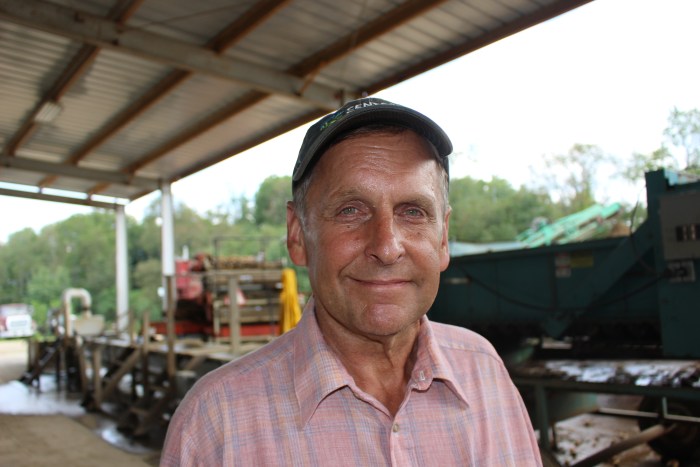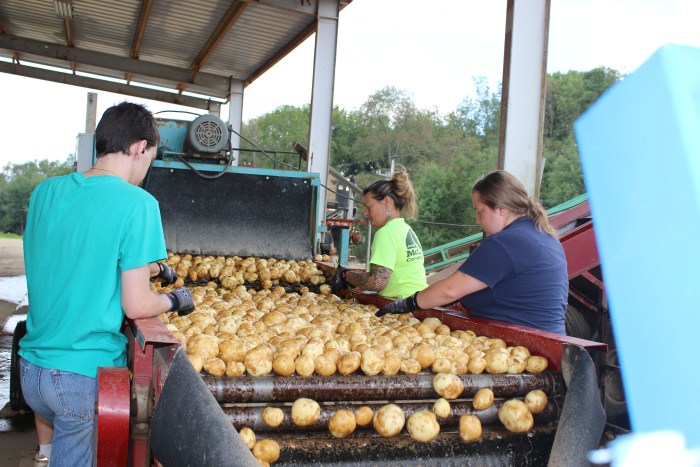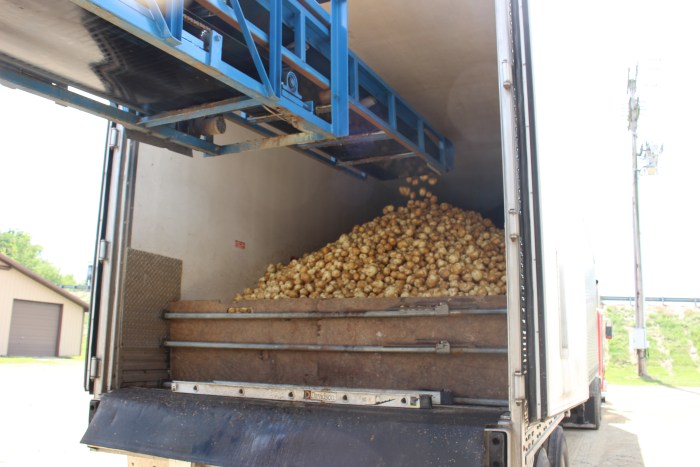Like many things, the price of potato chips has gone up. Ten years ago, the average price for a bag of chips was less than $4.50. Now it’s $6.50.
Potato industry experts blame inflation, but rising temperatures are also a factor.
Listen to the story

Kevin Troyer, 65, has been working on potato farms since he was 4. Photo: Julie Grant/Allegheny Front
Erie County Potato (Chip) Farms
It hasn’t been too hot this summer in Waterford, Pennsylvania, near Lake Erie, which has been a good thing for Kevin Troyer’s potato crop.
The truck stopped next to the barn on his farm.
“These packages are fresh off the fields. Look, we have packages that just arrived there,” Troyer said.
He watched as a truck unloaded a load of Atlantics onto a conveyor belt, an old variety with white skin and starchy flesh that is used to make potato chips.After removing any debris or dirt and washing the potatoes twice, workers sort out any that are undersized or damaged.

A worker removes damaged and undersized potatoes on Kevin Troyer’s farm in Waterford, Erie County, Pennsylvania. Photo by Julie Grant/Allegheny Front
They will load more than 50,000 pounds of washed and sorted potatoes onto separate trucks for the three-hour drive to Snyder’s plant in Berlin, southeast of Pittsburgh. Ownership has changed However, it continues to manufacture chips under the same name.

Potatoes are trucked from Kevin Troyer’s farm to Snyder’s in Berlin, a suburb of Pittsburgh. Photo: Julie Grant/Allegheny Front
““Hauling potatoes is one of our big expenses,” Troyer said, “hauling them to the chipper, hauling them from the field, hauling the seeds. We get a lot of our seeds from the upper Midwest.”
Transportation costs make up about a third of the cost of producing potatoes, Troyer said.
PA tops the list with snacks
Pennsylvania is not a major potato-growing state like Idaho or Washington. The U.S. Department of Agriculture states: Tracking data on potato cultivation It was abolished nearly a decade ago because states had become too small.
But there is one aspect of the U.S. potato economy in which Pennsylvania still wields great influence.
““Pennsylvania is known as the snack food capital of the world,” said Nathan Tallman, CEO of the Pennsylvania Potato Growers Cooperative.
“And our state has more potato chip factories than any other state in the Union.”

Pennsylvania has the most potato chip manufacturers and is the snack capital of the U.S. Photo: Julie Grant/Allegheny Front
Tallman connects potato farmers with chip manufacturers, and like the Troyers, he blames the rising cost of potato chips on inflation, with transportation costs a big factor in the price hike.
““Chip manufacturers want to grow potatoes here,” he said.
“It’s cheaper to ship potatoes from a farm in Pennsylvania to, say, Hanover.[Snyder’s of Hanover snack company, based in Pennsylvania] It’s not like coming from Florida, Michigan or Alliston, Ontario.”
Pennsylvania semiconductor manufacturers often import potatoes from these regions and the Northwestern United States because the potatoes are grown in large quantities in these regions, which are less hilly than Pennsylvania, have larger land areas, longer growing seasons, and have extensive mechanical irrigation systems.
Potatoes are difficult to grow
“You’re trying to grow crops, and crops are sensitive to weather and water conditions,” says Bob Raby, who has spent most of his career as a professor in Lehigh University’s College of Agriculture. County extension director focused on potato farmers.
He is now an agronomist for the Tallman Potato Cooperative. Raby would like to grow more potatoes in Pennsylvania, but it is becoming more difficult to do so in some parts of the state.
Potatoes grow best when daytime temperatures are between 60 and 65 degrees. Fahrenheit Once soil temperatures reach 85 degrees, growth will stop completely.
“We’ve seen that quite a bit. When we have sunny days and temperatures in the low 90s Fahrenheit, it’s easy for soil temperatures to rise well beyond the range where tubers can continue to grow,” Raby said.
Pennsylvania State Climatologist Researchers at Pennsylvania State University found that many parts of the state have seen an increase in hot afternoons with temperatures reaching 85 degrees or higher in recent decades.
For example, Lancaster County, Pennsylvania’s potato-growing region, is experiencing 15 more days per year with temperatures reaching 90 degrees Fahrenheit than it did 25 years ago — that’s more than two more weeks of extremely hot weather.

Number of days with a maximum temperature of 90°F or higher at Lancaster Airport, Pennsylvania, January-December 1999-2023. Courtesy of the Northeast Regional Climate Center’s Applied Climate Information System.
“If it’s a hot month, [a potato crop] It stops growing and never bounces back,” Raby said.
Potatoes also need cool nighttime temperatures.
“Nighttime temperatures below 57 degrees are also very important,” Raby said.
But Erie County, the state’s largest potato-growing region where Troyer is located, is also seeing an increase in warm nights. Since the 1980s, Erie has seen 15 more nights with lows above 65 degrees Fahrenheit.

Number of days with minimum temperatures above 65°F, January-December 1999-2023 (Erie International Airport, Pennsylvania). Courtesy of the Northeast Regional Climate Center’s Applied Climate Information System.
Star in the potato
“If the climate is changing, and it’s changing rapidly, we need to develop potatoes that are adapted to the new climate,” he said. Walter DeJong Professor at Cornell University.
He laughed when he heard Bob Raby call him a “rock star potato breeder.”
DeJong said continuing to rely on potatoes from Florida and the Northwest to supply Pennsylvania’s semiconductor manufacturers is not sustainable.
In addition to transportation and fuel costs, “Is there sustainable water available to grow potatoes indefinitely in the West?” he asked. “I think the answer is no. There are growing water use issues in the West.”
That reliance on Western potatoes changed in 2011 when Cornell University launched a potato developed by DeJong called “Lamoka,” named after a lake in New York. With this new variety, DeJong aimed to produce a potato chip that would retain its pale color when fried.
But the technology had an unintended beneficial property: It allowed Pennsylvania farmers to harvest potatoes in the fall, store them over the cold winter, and sell them to chip makers in the spring.
““Before LaMocca, if a chip plant in Pennsylvania wanted to make potato chips after mid-April, they had to get potatoes from Florida,” he says, “so there were a lot of transportation costs involved in getting the potatoes from Florida.”
Transportation costs are just one aspect of the price of potato chips — there are also the prices of cooking oil, fertilizer, labor and land — but De Jong, who experienced food shortages during the COVID-19 pandemic, believes it’s important to maintain local potato production, even if it means higher chip prices.
““Potatoes produced in the West may be cheaper, but in a disaster year there is social value in them being produced in the Northeast as well,” he said.
The question is, will consumers also see the value and be willing to pay for it?
#climate #change #blame #rising #cost #potato #chips #numbers #Allegheny #Front